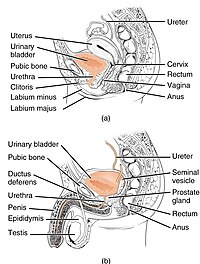
Pelvic floor muscle function, pelvic floor dysfunction and diastasis recti abdominis: Prospective cohort study
Sign Up to like & getrecommendations! Published in 2017 at "Neurourology and Urodynamics"
DOI: 10.1002/nau.23005
Abstract: Compare vaginal resting pressure (VRP), pelvic floor muscle (PFM) strength, and endurance in women with and without diastasis recti abdominis at gestational week 21 and at 6 weeks, 6 months, and 12 months postpartum. Furthermore,… read more here.
Keywords: pelvic floor; floor muscle; floor; diastasis recti ... See more keywords

The evaluation of pelvic floor muscle strength in women with pelvic floor dysfunction: A reliability and correlation study
Sign Up to like & getrecommendations! Published in 2018 at "Neurourology and Urodynamics"
DOI: 10.1002/nau.23287
Abstract: The purposes of this study were: (i) to evaluate the reliability of vaginal palpation, vaginal manometry, vaginal dynamometry; and surface (transperineal) electromyography (sEMG), when evaluating pelvic floor muscle (PFM) strength and/or activation; and (ii) to… read more here.
Keywords: strength; pelvic floor; floor muscle; floor ... See more keywords

Does pelvic floor muscle maximum voluntary contraction improve after vaginal pelvic organ prolapse surgery? A prospective study
Sign Up to like & getrecommendations! Published in 2018 at "Neurourology and Urodynamics"
DOI: 10.1002/nau.23503
Abstract: to assess pelvic floor muscle maximum voluntary contraction (MVC) before and after surgical treatment for pelvic organ prolapse (POP). read more here.
Keywords: pelvic floor; voluntary contraction; muscle maximum; maximum voluntary ... See more keywords

The effects of pelvic floor muscle therapy on symptoms, voiding, and pelvic floor muscle activity parameters in children with overactive bladder
Sign Up to like & getrecommendations! Published in 2019 at "Neurourology and Urodynamics"
DOI: 10.1002/nau.24007
Abstract: Refractory overactive bladder (OAB) in children can be treated with second line modalities such as as biofeedback, transcutaneous electrical stimulation (TENS), and botulinum toxin. In this study, we aimed to investigate the efficacy of biofeedback‐assisted… read more here.
Keywords: floor muscle; pelvic floor; overactive bladder;

Anthropometric indicators as predictors of pelvic floor muscle distress in young women
Sign Up to like & getrecommendations! Published in 2020 at "Neurourology and Urodynamics"
DOI: 10.1002/nau.24406
Abstract: To identify anthropometric indicators that could predict pelvic floor muscle distress (PFMD) in young women. read more here.
Keywords: pelvic floor; anthropometric indicators; young women; floor muscle ... See more keywords

Using codesign to develop a mobile application for pelvic floor muscle training with an intravaginal device (femfit®).
Sign Up to like & getrecommendations! Published in 2021 at "Neurourology and urodynamics"
DOI: 10.1002/nau.24775
Abstract: AIMS The aim of this project was to use codesign to develop a mobile application (app) for pelvic floor muscle training, with an intravaginal device (femfit®). The objective was to obtain user feedback to guide the… read more here.
Keywords: develop mobile; pelvic floor; mobile application; floor muscle ... See more keywords

The influence of prostatectomy and body position on location and displacement of pelvic landmarks with pelvic floor muscle contraction.
Sign Up to like & getrecommendations! Published in 2021 at "Neurourology and urodynamics"
DOI: 10.1002/nau.24794
Abstract: AIMS To compare pelvic floor muscle (PFM) anatomy and function (i) between pre- and post-prostatectomy in standing, and (ii) between sitting and standing postprostatectomy. METHODS Thirty-two men scheduled to undergo a prostatectomy volunteered to participate.… read more here.
Keywords: pelvic floor; prostatectomy; pelvic landmarks; anatomy ... See more keywords

Exploring pelvic floor muscle function in men with and without pelvic floor symptoms: A population‐based study
Sign Up to like & getrecommendations! Published in 2022 at "Neurourology and Urodynamics"
DOI: 10.1002/nau.24996
Abstract: Pelvic floor symptoms (PFS), such as lower urinary tract symptoms, defecation disorders, sexual problems, and genital‐pelvic pain, are prevalent in men. Thorough physical assessments of the external anal sphincter (EAS) and the puborectal muscle (PRM)… read more here.
Keywords: pelvic floor; floor muscle; floor symptoms; floor ... See more keywords

Effects of external electrical stimulation added to pelvic floor muscle training in women with stress urinary incontinence: A randomized controlled study
Sign Up to like & getrecommendations! Published in 2022 at "Neurourology and Urodynamics"
DOI: 10.1002/nau.25022
Abstract: In this study, the combination of external electrical stimulation (EES) with pelvic floor muscle training (PFMT) was assessed to determine if it yielded better results than PFMT or EES alone for treatment of stress urinary… read more here.
Keywords: pelvic floor; floor muscle; muscle training; electrical stimulation ... See more keywords

The effects of an 8‐week hypopressive exercise training program on urinary incontinence and pelvic floor muscle activation: A randomized controlled trial
Sign Up to like & getrecommendations! Published in 2022 at "Neurourology and Urodynamics"
DOI: 10.1002/nau.25110
Abstract: Pelvic floor dysfunction and urinary incontinence are two of the most frequent gynecological problems, and pelvic floor muscle training is recommended as a first‐line treatment, with new approaches such as hypopressive exercises. This study aimed… read more here.
Keywords: pelvic floor; urinary incontinence; floor; floor muscle ... See more keywords

Pelvic floor muscle training: Novel versus traditional remote rehabilitation methods. A systematic review and meta‐analysis on their effectiveness for women with urinary incontinence
Sign Up to like & getrecommendations! Published in 2023 at "Neurourology and Urodynamics"
DOI: 10.1002/nau.25150
Abstract: To investigate the effectiveness of supervised remote rehabilitation programs comprising novel methods of pelvic floor muscle (PFM) training for women with urinary incontinence (UI). read more here.
Keywords: pelvic floor; remote rehabilitation; floor muscle; urinary incontinence ... See more keywords